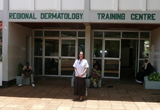 There are many differences between healthcare and medical education in Tanzania and in the UK, but the concept I find hardest to understand is “attendance or sitting allowance.” This allowance is paid to all staff who attend courses for their healthcare education and it seems that staff will not attend educational events unless they are paid their attendance allowance. The allowance can be a significant sum and the educational facility providing the training event is expected to cover the cost.
There are many differences between healthcare and medical education in Tanzania and in the UK, but the concept I find hardest to understand is “attendance or sitting allowance.” This allowance is paid to all staff who attend courses for their healthcare education and it seems that staff will not attend educational events unless they are paid their attendance allowance. The allowance can be a significant sum and the educational facility providing the training event is expected to cover the cost.
Apparently this practice originated many years ago when the WHO began running educational events and courses about HIV/AIDS and now seems to be ingrained. I am used to a society where we seek and pay for medical education and now with the reduction of study budgets it is common practice to self-fund attendance at courses and meetings.
Now I understand that western salaries are much greater than salaries paid in Tanzania but mixing economics with education seems to be detrimental to the will to learn. Perhaps a different form of attendance bonus allowance based on an 80% attendance in the workplace per year would be more successful, although I am not sure how it would be policed or funded.
Meanwhile the Tanzanian government is struggling to meet the 100% pay increases for doctors and nurses that were agreed as a result of a recent strike. This is due in part to the fact that within a population of 45 million there are only an estimated 800,000 tax payers. There was another mini-strike of two days recently and we are awaiting a re-shuffling of the cabinet. I don’t think there will be many willing volunteers stepping forward for the job of Health Minister.
On the ward we currently have four Spanish surgeons who come each year to the Regional Dermatology Training Centre, at their own expense, for a ten day period, to operate on our patients and train the dermatology residents in surgery and dermatopathology. Last Monday was amazing as there were over 100 Albino and Xeroderma Pigmentosa patients in the department being screened for surgery. All the patient’s expenses are paid for by a Spanish organisation, as well as attendance allowance for the local staff. Some of the patients had travelled for two days across Tanzania thinking they had skin cancer to be told they had tinea capitis (a fungal infection of the scalp).
Xeroderma pigmentosa is a dreadful autosomal recessive disease where there is a defect in the gene responsible for repairing DNA following photodamage. Photodamage begins in early childhood and is characterised by cutaneous and ocular changes such as freckles, photophobia, corneal keratitis, and ulceration. In Africa if strict photo-protection is not adhered to then malignant tumours such as squamous cell carcinomas, basal cell carcinomas, keratoacanthomas, and malignant melanomas develop in children as young as three and four and death from metastatic disease can occur from the teenage years. It is very difficult to arrange for children to be operated on under general anaesthetic due to no dedicated paediatric theatre space. It is the first place I have worked where adults are prioritised over children but perhaps this is due to economics as well. As in many places there seems to be a two tiered system with those who can pay being fast-tracked to theatre and those who can’t waiting weeks and sometimes months. We have watched a young child’s scalp tumours multiply five fold whilst an inpatient for six weeks. I have found this the hardest part of my job—watching but not being able to get the child to theatre as inevitably there is an adult emergency and they are bumped off the list. This week thankfully the child was operated on. The dermatology department is currently building its own wards and theatres so if dedicated anaesthetic time can be arranged, and this is a big if, we will be at last be able to operate on our patients.
Susannah Baron is a consultant dermatologist.